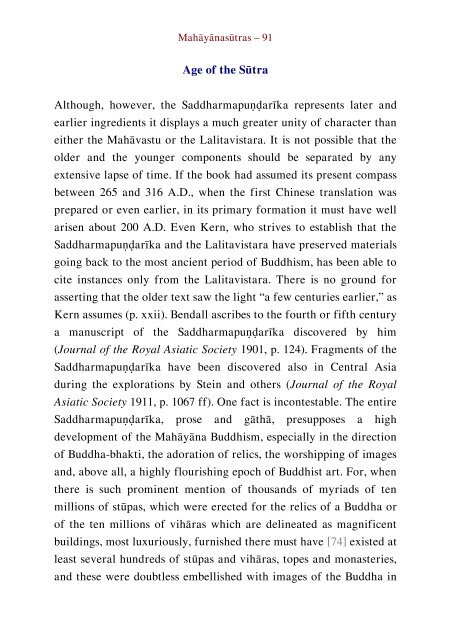Literary History of Sanskrit Buddhism
A study by J. K. Nariman of Sanskrit Buddhism from the Early Buddhist Tradition up to the Mahayana texts proper.
A study by J. K. Nariman of Sanskrit Buddhism from the Early Buddhist Tradition up to the Mahayana texts proper.
You also want an ePaper? Increase the reach of your titles
YUMPU automatically turns print PDFs into web optimized ePapers that Google loves.
Mahāyānasūtras – 91<br />
Age <strong>of</strong> the Sūtra<br />
Although, however, the Saddharmapuṇḍarīka represents later and<br />
earlier ingredients it displays a much greater unity <strong>of</strong> character than<br />
either the Mahāvastu or the Lalitavistara. It is not possible that the<br />
older and the younger components should be separated by any<br />
extensive lapse <strong>of</strong> time. If the book had assumed its present compass<br />
between 265 and 316 A.D., when the first Chinese translation was<br />
prepared or even earlier, in its primary formation it must have well<br />
arisen about 200 A.D. Even Kern, who strives to establish that the<br />
Saddharmapuṇḍarīka and the Lalitavistara have preserved materials<br />
going back to the most ancient period <strong>of</strong> <strong>Buddhism</strong>, has been able to<br />
cite instances only from the Lalitavistara. There is no ground for<br />
asserting that the older text saw the light “a few centuries earlier,” as<br />
Kern assumes (p. xxii). Bendall ascribes to the fourth or fifth century<br />
a manuscript <strong>of</strong> the Saddharmapuṇḍarīka discovered by him<br />
(Journal <strong>of</strong> the Royal Asiatic Society 1901, p. 124). Fragments <strong>of</strong> the<br />
Saddharmapuṇḍarīka have been discovered also in Central Asia<br />
during the explorations by Stein and others (Journal <strong>of</strong> the Royal<br />
Asiatic Society 1911, p. 1067 ff). One fact is incontestable. The entire<br />
Saddharmapuṇḍarīka, prose and gāthā, presupposes a high<br />
development <strong>of</strong> the Mahāyāna <strong>Buddhism</strong>, especially in the direction<br />
<strong>of</strong> Buddha-bhakti, the adoration <strong>of</strong> relics, the worshipping <strong>of</strong> images<br />
and, above all, a highly flourishing epoch <strong>of</strong> Buddhist art. For, when<br />
there is such prominent mention <strong>of</strong> thousands <strong>of</strong> myriads <strong>of</strong> ten<br />
millions <strong>of</strong> stūpas, which were erected for the relics <strong>of</strong> a Buddha or<br />
<strong>of</strong> the ten millions <strong>of</strong> vihāras which are delineated as magnificent<br />
buildings, most luxuriously, furnished there must have [74] existed at<br />
least several hundreds <strong>of</strong> stūpas and vihāras, topes and monasteries,<br />
and these were doubtless embellished with images <strong>of</strong> the Buddha in


















